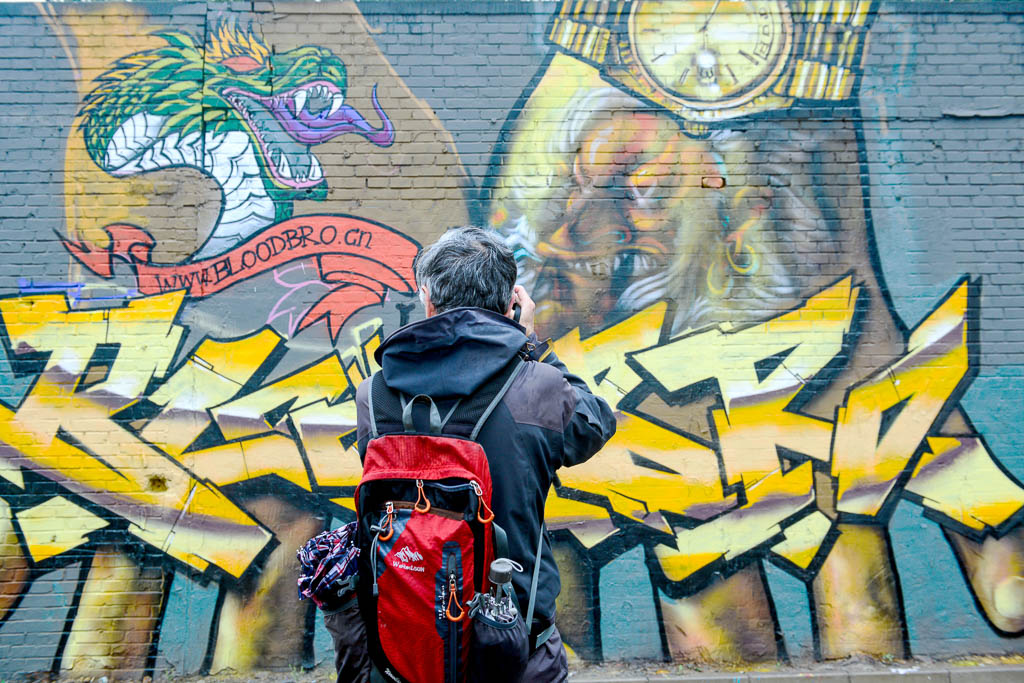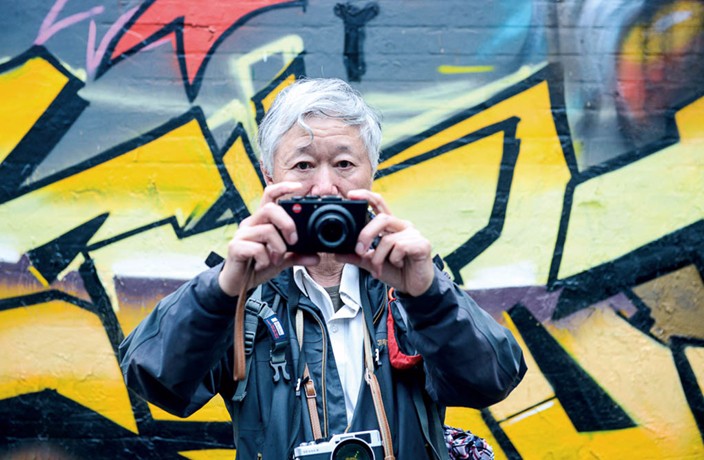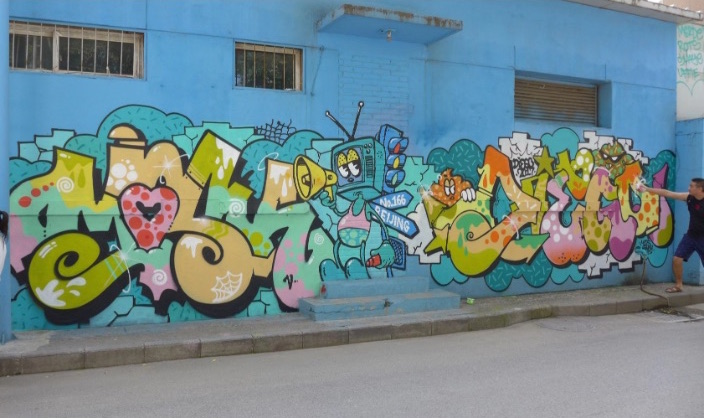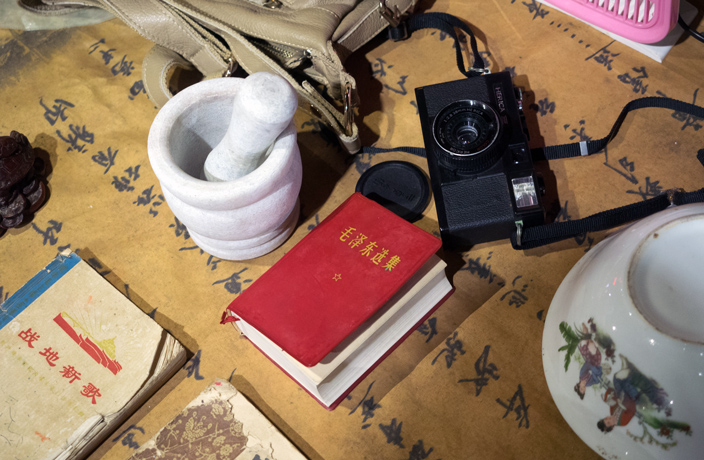Gangs, aliases, curses, authority figures and middle-of-the-night dalliances – if this sounds like the premise of a salacious book, that’s probably because it is. Beijing Graffiti is an unpublished book by the mysterious photographer LLYS, aka Liu.
Known on the streets as ‘Liu laoshi,’ the 62-year-old Beijinger has spent the best part of 12 years documenting the city’s graffiti. He has taken countless images – his book alone features 700 – and, in the process, has developed something of a cult following.

Liu takes a photo of a graffiti-sprayed wall at a graffiti event, photo by Holly Li

By SHUO, Guloudajie subway station (Mar 10, 2014; works disappeared) 11. By unknown, Gulou Dongdajie (Mar 21, 2013; works disappeared)

By GUNScrew, 798 Art District (Apr 28, 2013; works disappeared)
A former designer and reporter for a government magazine, Liu’s interest in graffiti was sparked after he noticed the transient nature of street art. He tells us: “I used to take photos of ‘nice’ things like flower shops. But once, after taking a photo of graffiti, I noticed that it had been cleaned away a few days later. From that point on, I realized I needed to focus on documenting street art.”
This was back in 2004 – before the ubiquitous rabbit head appeared on walls and doors from Dongcheng to Chaoyang, before graffiti was used in trendy restaurant design, and way before legal, organized graffiti events, like the one we meet Liu at.

By Cookies, Beijing Institute of Fashion Technology (Aug 17, 2010; works disappeared)
By all appearances, Liu is an unlikely bastion of Beijing street art. Wearing a waterproof jacket and walking shoes, with a head of thick gray hair and a camera around his neck, he looks more like a tourist than hardcore graffiti archivist. But the proof is in his book.
Beijing Graffiti is a 400-page, 10-year record of the capital’s street art. Many of its images can be found on Liu’s microblog, a platform that has cemented his status in the local graffiti scene as the ‘teacher.’
“I used to finish work around 4pm, which would give me time to go out and take a look at what was happening on the streets,” he explains.
Moving around on foot rather than bicycle (“too limiting”), Liu discovered new scenes and – eventually – friends, he says.
“The first time I saw [graffiti group] Guanyin spraying, I was too shy to introduce myself because I look a bit older. But after they saw photos of their graffiti on my blog, they realized I was the man taking pictures and left a nice message.”

By unknown, Jingmi Lu (Nov 24, 2014; works disappeared)

By Liu Yuchen, et al, Beijing Institute of Fashion Technology (Jul 24, 2009; works disappeared)
It’s difficult to reconcile this version of Liu with the one we witness at the graffiti event. Liu is in his element here. When not taking photos of graffiti like a pro, he’s chatting with the artists as if they’re old friends. ANDC, co-organizer of the event and member of professional graffiti group ABS Crew, is a busy man, but stops nonetheless for a catch-up with the ‘teacher.’ “I met Liu laoshi when I was first doing graffiti in Beijing back in 2007,” he shares.
Other artists we meet reminisce about Liu helping them out when the bao’an (security) would drop by and ask questions. It seems everyone has a story about Liu laoshi – or is it the other way round?
“There are rival teams who each have their own ‘designated’ area,” Liu explains. “Sometimes teams will go into their rival’s area and cover up their graffiti.

By CAMEL617, Sidaokou (Aug 5, 2010; works disappeared)
“Philip, an Italian artist, was spraying in a graveyard one night. He stepped on a grave unknowingly and afterwards came down with a fever. An old man told him to go back and burn paper money at the spot, so he did, and was cured. Many graffiti artists have similar stories.”
Liu’s connections mean he has an insider’s perspective on Beijing’s graffiti world. “The community here is pretty small, compared to other countries. There are only about one or two hundred [artists in Beijing]. But every year it’s different. It was most active around 2008 to 2009 and least active in 2015.”
This is due in part to the quick-moving nature of Beijing, according to Liu. “People leave or just pass by. Many are from overseas or Hong Kong. I also notice there are a lot of people who’ve just graduated and started working.”

By 0528 et al, 3.3 mall underground parking, Sanlitun (Sep 21, 2006)
While the scene has grown a lot in the past decade, it’s still nowhere near as large as in places like Brazil or New York. The difference comes down to culture, Liu surmises: “I feel that it’s about personality – Chinese people are less used to expressing themselves. Graffiti goes against their character. Although there are many Chinese people who like painting and fine arts; graffiti, less so.”
Graffiti in China may be less entrenched but it is distinct, argues Liu, who has also photographed street art in Hong Kong, Shanghai and Taiwan. “The art form originated from overseas but artists employ Chinese culture to express themselves,” he says, pointing to the use of calligraphy as an example.
“There are two types of graffiti: calligraphy and text, or painting [images]. I prefer painting.” Does he have a favorite artist? “Zato!” Liu says, smiling. “I pay attention to his work because it’s very distinctive. He sprays Chinese words, whereas most artists spray in English.” Zato is from the US, Liu says, but is “very shy and wary of the media.”
Nonetheless, the characteristic ‘Zato’ signature can be still be seen all around Beijing. Liu explains: “He likes dangerous, difficult-to-spray areas. Graffiti artists are attracted to risky places and there is sometimes competition between the artists. They try to spray at the highest points.”

By Rogue Boy, 798 Art District (Nov 10, 2008; works disappeared)
When talking graffiti, Liu exudes an infectious energy. The graffiti game is always changing, he stresses, and so are its players.
“Since moving to Shunyi and retiring, there are fewer chances for me to go out and take photos. I’m a family guy – now that I have more free time, I feel I should spend it with my wife and our dog. We like to travel.
“But I do really miss [graffiti],” he adds. “I usually just come in now for special events like this one.
“As it’s raining today my wife prefers to stay inside, so it’s a good opportunity for me to go out,” he laughs. Liu’s wife and dog have joined him at events, but as their dog grows older, this has become less practical.

By JEKA, Baihua Shenqu Hutong, Xinjiekou (Aug 29, 2004; works disappeared)
Retirement has also given Liu time to put his book together. Categorized by year, Beijing Graffiti is a sprawling account of the city’s street art scene. Filled with rare snaps and secret stories, it’s a gem of a document. Yet it remains without a publisher.
“People like the book but they don’t believe it will sell. Another reason is that publishers are afraid – they’re wary of possible political ramifications,” he explains.
Liu’s graffiti escapades may have quietened down these days but his passion remains. “It’s not about me. I don’t care about anything else. My only goal is to publish my book so that people can see the beautiful art that was on the walls.”
Images by LLYS/main photo by Holly Li
To see more of Liu’s photos, visit blog.sina.com/ppttyy.






















0 User Comments